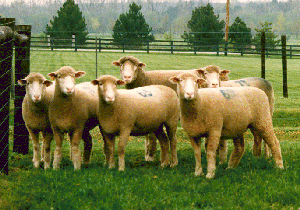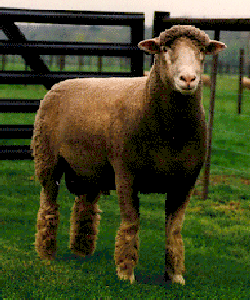<!--[endif]--><!--[if gte mso 10]> <mce:style><! /* Style Definitions */ table.MsoNormalTable {mso-style-name:"جدول عادي"; mso-tstyle-rowband-size:0; mso-tstyle-colband-size:0; mso-style-noshow:yes; mso-style-parent:""; mso-padding-alt:0cm 5.4pt 0cm 5.4pt; mso-para-margin:0cm; mso-para-margin-bottom:.0001pt; mso-pagination:widow-orphan; font-size:10.0pt; font-family:"Times New Roman"; mso-ansi-language:#0400; mso-fareast-language:#0400; mso-bidi-language:#0400;} -->
<!--[endif]-->
History of the Dorset Horn & Poll Dorset Sheep
The Dorset Horn sheep is one of the earliest recorded breeds of British Sheep with the first Flock Book being established in 1892, and its adaptability was soon recognised world wide.
The Australians, noted for their shepherding skills, soon realised the potential of the sheep to improve their existing stock and imported the Dorset Horn. With their vast acreage and minimal management techniques the viability of producing a hornless Dorset was of prime interest. This they achieved and the Poll Dorset emerged to provide the sheep now so much in demand throughout the world.
In the mid 1950s a far sighted Dorset breeder, "Bunny" Lenthall, decided to investigate the potential of the Poll Dorset and, after a visit to Australia, returned with two stud rams. In the UK the Poll Dorset now out numbers its illustrious ancestor but all the attributes of the Dorset Horn still apply to both.
Today the breed has moved on retaining all the same characteristics but it is assisted by up-to-date techniques of record keeping such as that provided by Signet. Now with a recently introduced Sire Reference Scheme the breed is developing further to provide even better breeding stock and conformation to fulfil market needs.
The Association's first Patroness in 1892 was Her Majesty, Queen Victoria, and with this strong foundation it has grown world wide to promote the breed internationally via shows and the media to maintain the breed's profile.

Standard of Excellence for Dorset Horn & Poll Dorset Sheep
RAMS
Bold, masculine appearance, with good length, strength and of robust character, and head of great beauty. With regard to the Horn Ram, strong and long horns growing from the head well apart on the crown in a straight line with each other and coming downwards and forwards in graceful curves as close to the face as may be without cutting.
EWES
Appearance bright with feminine characteristics. With regard to the Horn Ewe the horns much smaller and more delicate that in the Ram
|
HEAD: |
Broad, full and open at the nostril, well covered with wool from brow to poll, face white with pink nose and lips free from pigmentation. |
|
EARS: |
Medium size, white and firm, well covered with hair. |
|
MOUTH: |
Even, well set jaw with flat chisel shaped teeth, meeting a wide pad with a firm bite. |
|
NECK: |
Short to medium length and round, well sprung from the shoulders, with no depression at collar, strong and muscular, especially in the Ram. |
|
CHEST: |
Well forward, full and deep. |
|
FORE FLANK: |
Full, with no depression behind the shoulders. |
|
SHOULDERS: |
Well laid and compact. |
|
BACK & LOINS: |
Broad, long and straight, with well sprung ribs. |
|
QUARTERS: |
Full, broad and deep with flesh extending to the hocks and well muscled thighs. |
|
TAIL: |
Well set up in a line with the back, wide, firm and fleshy. |
|
RIBS: |
Well sprung from the back and deep at the sides. |
|
LEGS & PASTERNS: |
Medium length, well placed at the four quarters and free moving, straight between the joints, with strong bone, well woolled to the knees and hocks with pasterns well set up and straight. |
|
WOOL: |
Fine “down” type wool, dense and firm handling, free from kemp and colour. |
Description:
|
RAMS: |
Bold, masculine appearance, and may weigh up to 113.5 kg (250lbs) when mature. |
|
EWES: |
Medium size and naturally prolific, so that depending on management, lamb crops may attain any figure from 130% - 170% or more. Growth rates of up to 0.45 kg (1lb) per day are frequently recorded producing carcasses from 16 kg (34 – 36lb) dressed carcass weight at 10 – 16 weeks of age. Ewes have a bright appearance, skin colour is pink, whilst the face, legs and ears are white. |
|
WOOL: |
Fleece of good staple and quality, compact and firm to the touch. |
Management of the Breed
Introduction
The objective of the Dorset Horn and Poll Dorset breeder is to have a flock which will lamb regularly lamb out of season and produce the maximum number of lambs for sale, either as well grown breeding ewes or as prime lambs for the current requirements of the meat trade.
To achieve this objective replacement breeding stock should be sought from flocks that have regularly lambed at the period you require for the farming calendar. Most breeders will keep precise records of their flock's performance, thus making your selection easier.

The Flock
Whatever time of year you decide to plan your lambing , make sure your ewes are not excessively fat prior to tupping. This can be achieved by intensifying the ewes onto a smaller acreage, condition score, particularly the older and less fit ewes and adjust nutrition accordingly. This will enable you to flush the ewes prior to tupping efficiently.
The rams are good workers and are particularly well suited for early covering if used in a commercial flock. Many Dorset ewes will have a slightly shorter gestation period, averaging about 145 days and the first cross females will often inherit the frequent lambing ability.
Concentrate feeding prior to lambing need normally be kept to a minimum at most times of the year. If winter lambing is decided upon then some additional feeding will be necessary either in the form of a high energy feed block, as the grass deteriorates, and then a suitable concentrated cereal feed, up to 70 gms (1.5 lbs) per day, plus roughage or roots prior to lambing.
SIRES
"The ram is more than half of the flock", so the old phrase goes, and it is certainly as true today, if not more so in these times of tight profit margins.
Buy the best rams you can afford and look after them throughout the year. Make sure they are regularly drenched, vaccinated and their feet trimmed. Exercise is always important and do not let them become over fat.
Well before tupping check each ram over carefully and a few weeks before use increase their nutrition.
EWES
The same rules apply for the care of ewes as that of rams, and do not let them get over fat at any time particularly around lambing and weaning the lambs.
LAMBING
The Dorset Horn and Poll Dorset ewe is an excellent mother and has good milking ability. Flock Masters may need to assist, as with any other breed, hoggets lambing for the first time. Hygiene at lambing time is of paramount importance whether lambing indoors our out, and good record keeping will always assist you to make your flock as profitable and trouble free as possible.
FEEDING AFTER LAMBING
Traditionally root crop feeding or folding, with a separate creep for the lambs has been practised but more recently with the introduction of precision drilling and pre-emergent sprays etc. many incorporate main root crops like swedes or kales, together with later sowings of stubble turnips and the like. This can lend itself to various arable systems, e.g. early potatoes, winter wheat and barley breaks.
Flocks may also be maintained entirely on grass leys, the ewes utilising quality silage or hay during lactation with some concentrates being offered in severe weather conditions of if available feed lacks quality. As with traditional methods lambs should also be given creep feed.
Frequent Lambing Systems
If frequent lambing is to be practised, a high level of management and shepherding is required, but high lambing percentages and outputs are achieved annually and the income per ewe and acreage is rewarding.
It has to be asked initially how this will fit it with ones other farming enterprises and the labour available. The aim is for lambing to occur at eight month intervals.
Options
1. If run on natural lines, with suggested lambings in say November, March and July, with tupping being restricted to 5 weeks maximum at each time, a strict discipline by the Flock Master is required to take rams out at the end thus preventing lambing becoming continuous.
A teaser ram running with the ewes for 2/3 weeks prior to tupping can be advantageous as the lactating ewes will have lambs running at foot. The percentage of ewes which conceive may vary at times. Factors which may result in lower conception rates are a low level of nutrition at tupping, or adverse weather conditions, for example, drought.
Body scoring of ewes near to these tupping dates, at whatever time of year, can be beneficial, but should be done in time to make whatever adjustments necessary through feeding for optimal conception. A rising of condition is ideal. It is most vital that rams are in prime covering condition.
It must also be considered that this system demands additional enclosures in order to keep the level of management at its peak with two ages of ewes and lambs in groups. Female flock replacements can be lambed as hoggets at 16 - 20 months of age or introduced into any lambing batch.
2. A more scientific approach to frequent lambing of "Dorsets" is also being practised: by synchronising oestrus and the use of vaginal sponges pre-tupping, thereby aiding batch lambing.
Once again a close study of ewe nutrition is vital to successful flushing and through the first month of gestation. The early weaning of lambs at 8 weeks or so has been introduced, resulting in non lactating ewes at tupping.
Sheep housing may be practised more with this system, December/January born lambs would be lambed inside, then early weaned and fattened fast for the Easter trade, as may the previous batch born in August/September. The ewes too may be housed or yarded for a large part of the year, enabling a rigid profile of diet and management to be maintained. High profit margins are being achieved on such systems at these.



ساحة النقاش